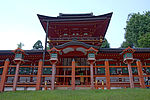| Hirano Shrine | |
|---|---|
 Hirano shrine torii gate | |
| Religion | |
| Affiliation | Shinto |
| Deity | Imaki-no-kami (今木神) Kudo-no-kami (久度神) |
| Year consecrated | 794 |
| Architecture | |
| Style | Kasuga-zukuri |
The Hirano Shrine (平野神社, Hirano-jinja) is a Shinto shrine in Kyoto, Japan. This shrine is known and popular for its gardens and many trees.
YouTube Encyclopedic
-
1/3Views:3 543488353
-
Cherry Blossoms at Hirano Shrine Kyoto Japan
-
(HD)京都・平野神社-Hirano Shrine,Kyoto
-
The Cherry-blossom viewing at Hirano Shrine in Kyoto.
Transcription
History
The shrine was established in the year 794 by Emperor Kammu when the capital was transferred to Heian-kyō from Nagaoka-kyō. From the earliest years, the shrine has been often visited by members of the Imperial family. In earlier centuries, the shrine also has connected a special relationship with both the Genji and the Heiji. It was the saved place from nature powered cases. And spirit Genji and Heiji sleep in the era. There was the capital of Tenno near by.
The shrine became the object of Imperial patronage during the early Heian period.[1] In 965, Emperor Murakami ordered that Imperial messengers were sent to report important events to the guardian kami of Japan. These heihaku were initially presented to 16 shrines including the Hirano Shrine.[2]
The shrine has been the site of a cherry blossom festival since 985. The long history of festivals at the Shrine began during the reign of Emperor Kazan, and it has become the oldest regularly held festival in Kyoto. Each year, the festival begins in the morning with a ceremony at the mausoleum of former Emperor Kazan. In the afternoon, a procession travels from the shrine into the neighbor area and back.
On 26 August 2018, the shrine suffered extensive damage from Typhoon Jebi, which it has struggled to recover from. The haiden was destroyed, as well as a few trees around the shrine.
The enshrined kami includes:
- Imaki-no-kami (今木神)
- Kudo-no-kami (久度神)
- Furuaki-no-kami (古開神)
- Hime-no-kami (比売神)
From 1871 through 1946, the Hirano Shrine was officially designated one of the Kanpei-taisha (官幣大社), meaning that it stood in the first rank of government supported shrines.[3]
See also
Notes
- ^ Breen, John et al. (2000). Shinto in History: Ways of the Kami, pp. 74-75.
- ^ Ponsonby-Fane, Richard. (1962). Studies in Shinto and Shrines, pp. 116-117.
- ^ Ponsonby-Fane, Richard. (1959). The Imperial House of Japan, pp. 124.
References
- Breen, John and Mark Teeuwen. (2000). Shinto in History: Ways of the Kami. Honolulu: University of Hawaii Press. ISBN 978-0-8248-2363-4
- Ponsonby-Fane, Richard. (1962). Studies in Shinto and Shrines. Kyoto: Ponsonby Memorial Society. OCLC 399449
- ____________. (1959). The Imperial House of Japan. Kyoto: Ponsonby Memorial Society. OCLC 194887
External links
- Official website (in Japanese)
35°01′57″N 135°43′55″E / 35.03250°N 135.73194°E

